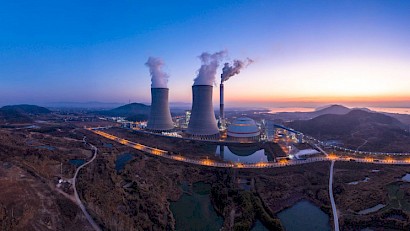Nuclear power is on the rise. And it could be the best way to nail zero-emissions
 As useful as it may be, nuclear power can be scary. From Chernobyl to Fukushima, there are a few memorable examples of nuclear power gone wrong.
As useful as it may be, nuclear power can be scary. From Chernobyl to Fukushima, there are a few memorable examples of nuclear power gone wrong.
But according to a new study published this Monday in the journal Nature, nuclear may be the cheapest way to a net-zero world.
And with projects like Bill Gates’ TerraPower on the way, the future is looking bright for nuclear.
Nuclear power: a necessary option?
“Renewable energy sources like wind and solar are great for reducing carbon-emissions,” said in statement study author Lei Duan of the Carnegie’s Department of Global Ecology. “However, the wind and sun have natural variation in their availability from day to day, as well as across geographic regions, and this creates complications for total emissions reduction.”
Currently, gaps created when the sun is not shining, and the wind is not blowing, are filled with natural gas. But this is not a solution for a net-zero emissions scenario. Nuclear is therefore considered as a viable, if not vital, option.
In their research, Duan, along with Ken Caldeira also of the Carnegie’s Department of Global Ecology and Robert Petroski of TerraPower LLC and Lowell Wood of Gates Ventures LLC, evaluated the wind and solar resources of 42 countries and looked at the cheapest way to eliminate carbon dioxide emissions based on today’s costs. They then used that data to deduce what would be nuclear power’s ability to replace natural gas as a backup energy source.
Promising potential
Their research showed that in countries such as the United States, which have access to ample wind power, nuclear would not be deployed until it was needed. However, in countries with poorer clean energy resources, such as Brazil, nuclear power was key to enabling a faster transition away from carbon.
“Under strict greenhouse gas emission controls, reliable power generation provided by nuclear power has a lot of potential value in the electricity grid for most nations,” Duan added. “Places with poor wind resources can benefit from nuclear earlier in the path to zero emissions, whereas places with very good wind resources would only need it to get rid of the last traces of carbon emissions.”
The researchers also found that, at the current pricing, nuclear is the most cost-effective solution to eliminate all electricity-system carbon emissions nearly everywhere. However, if energy storage technologies become very affordable, wind and solar could potentially be the most cost-effective approach to a zero-emission electricity grid.
Study abstract:
New designs of advanced nuclear power plants have been proposed that may allow nuclear power to be less expensive and more flexible than conventional nuclear. It is unclear how and whether such a system would complement variable renewables in decarbonized electricity systems. Here we modelled stylized electricity systems under a least-cost optimization framework taking into account technoeconomic factors only, considering electricity demand and renewable potential in 42 country-level regions. In our model, in moderate decarbonization scenarios, solar and wind can provide less costly electricity when competing against nuclear at near-current US Energy Information Administration (US$6,317 per kilowatt-electric (kWe)) and at US$4,000 kWe−1 cost levels. In contrast, in deeply decarbonized systems (for example, beyond ~80% emissions reduction) and in the absence of low-cost grid-flexibility mechanisms, nuclear can be competitive with solar and wind. High-quality wind resources can make it difficult for nuclear to compete. Thermal heat storage coupled to nuclear power can, in some cases, promote wind and solar.
You can return to the main Market News page, or press the Back button on your browser.

